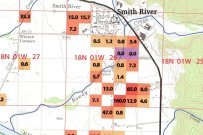Below is a link to Siskiyou Land Conservancy’s comments on the National Marine Fisheries Service draft of the Southern Oregon/Northern California Coast (“SONCC”) Coho Salmon Recovery Plan. Although the SONCC Coho were listed as “threatened” under the U.S. Endangered Species Act in 1997, NMFS is only just now completing a draft of a Recovery Plan for the species, as mandated by the Endangered Species Act.
Siskiyou Land Conservancy’s comments focus solely on the Smith River. Although the Smith is California’s most pristine major river, even here Coho are listed in the Recovery Plan as a “high extinction risk.” This is due in part to an overall decline of the entire SONCC population of Coho, but also in large part to destruction of Coho habitat at the Smith River estuary, and at Rowdy Creek, one of the two most important Coho spawning streams on the Smith. (The other major Coho tributary on the Smith River is Mill Creek, which also experienced widespread logging and therefore alteration of spawning habitat. But the lowermost reach of Mill Creek is protected by Jedediah Smith Redwoods State Park, and much of the upper reach is undergoing intensive restoration work led by the Smith River Alliance in partnership with State Parks, the state Department of Fish and Game (DFG), the Wildlife Conservation Board (WCB) and Save-the-Redwoods League.)
In large part, our comments focus on the Smith River estuary, where, as noted in the Recovery Plan, habitat destruction and simplification, and excessive pesticide use on surrounding Easter lily farms, pose the greatest threat to survival of Coho salmon in the Smith River.
SLC’s comments also emphasize the need to address continued clear-cut logging and herbicide applications by Green Diamond Resource Co. on Rowdy Creek, which runs through the Smith River estuary. The SONCC Coho Recovery Plan contained only one paragraph on Green Diamond’s ownership in the Smith River basin, a “punt” to the wholly inadequate Aquatic Habitat Conservation Plan devised by the company.
Please feel free to comment on this paper. We appreciate your input.
Greg King, Executive Director

